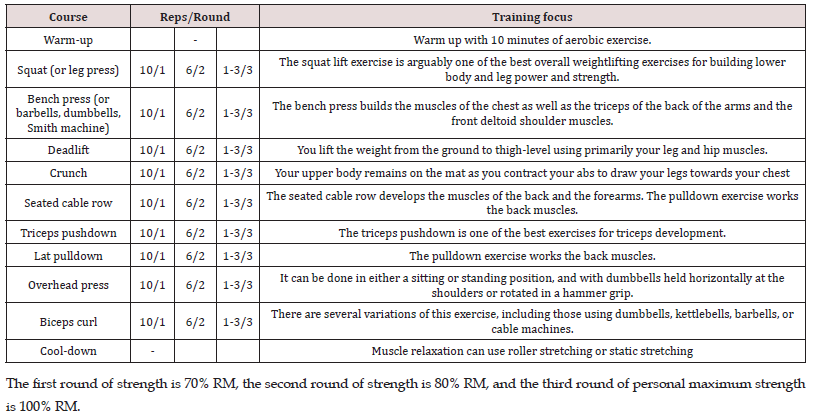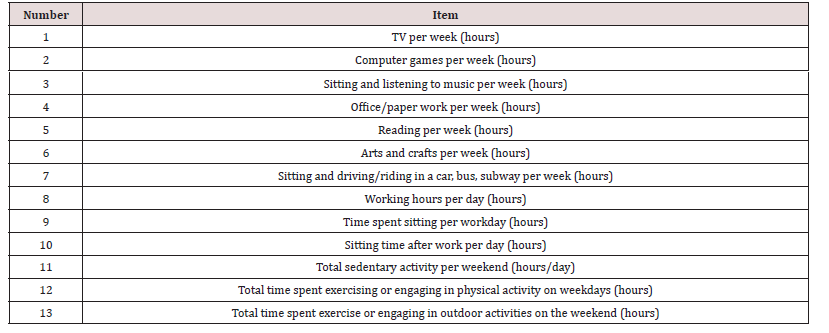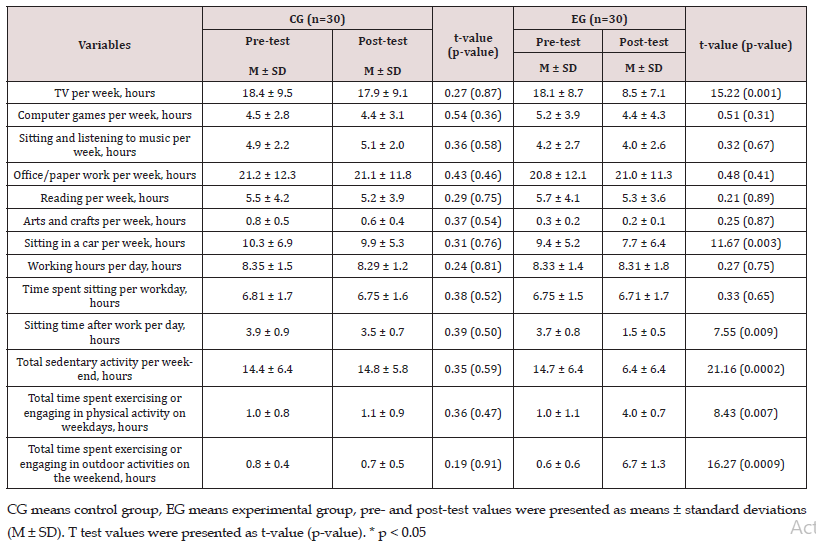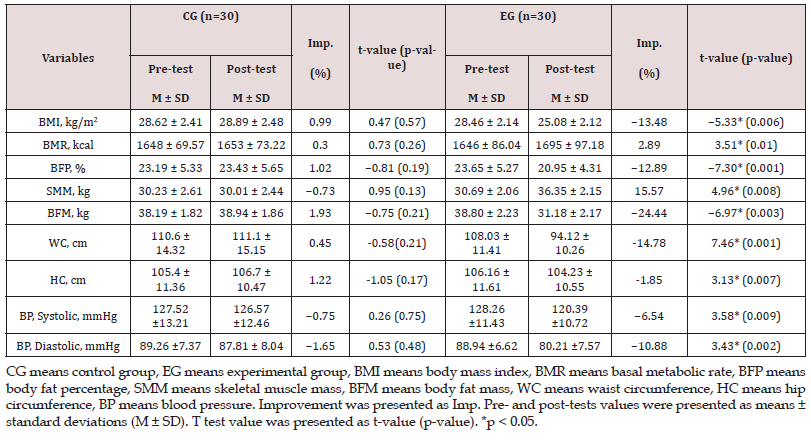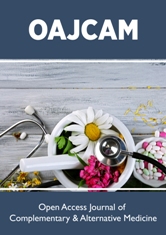
Lupine Publishers Group
Lupine Publishers
Menu
ISSN: 2644-1217
Research ArticleOpen Access
Sedentary Behavior, Body Composition, Upper Extremity Muscle Strength and lower extremity muscle mass in Middle- Aged: An Intervention Study Volume 4 - Issue 4
Fan Chia1, Wei-Yang Huang2 and Cheng-En Wu 3*
1Office of Physical Education and Sport, National Chung Hsin University, Taichung, Taiwan
2Physical Education Leader, National Taiwan College of Performing Arts, Taipei, Taiwan
3Office of Physical Education, Tamkang University, No. 151, Ying-Zhuan Rd., Tamshui, New Taipei City 251301, Taiwan
Received: June 03, 2023 Published:June 08, 2023
*Corresponding author: Cheng-En Wu, Office of Physical Education, Tamkang University, No. 151, Ying-Zhuan Rd., Tamshui, New Taipei City 251301, Taiwan
DOI: 10.32474/OAJCAM.2023.04.000193
Abstract
The purpose of this study was to intervene with a resistance training program, primarily aimed at improving sedentary behavior, body composition and blood pressure, enhancing upper extremity muscle strength, and increasing lower extremity muscle mass. This research method recruited 60 healthy middle-aged males who were still working in the community and randomly assigned them to an experimental group or a control group. The experimental group underwent a resistance training program (90 min sessions twice a week, for a total of 36 sessions over 18 weeks), and the control group carried out their usual daily activities. Testing tools and items included a sedentary behavior questionnaire, InBody520 bioelectrical impedance analysis, a tunnel-type electronic sphygmomanometer, constant tension tape measure to measure waist and hip circumference, a hand-held dynamometer to measure upper limb grip strength, and tape measure to measure lower limb calf circumference. The results of the study showed that the experimental group increased physical activity time, which in turn decreased sedentary behavior. Due to the intervention of resistance training, the skeletal muscle mass of the experimental group increased significantly, the systolic and diastolic blood pressure decreased significantly, the average ratio of waist and hip circumference was 0.903, the handgrip strength increased to 38.59 kg, and the circumference of the calf increased to 36.21 cm. It confirmed that handgrip strength was a reliable indicator for assessing upper extremity muscle strength, and the cut-off value of calf circumference can be used as a criterion for assessing lower extremity muscle mass. The study concluded that moderate intensity exercise or physical activity could help middle-aged adults reduce sedentary behavior, improve body composition and blood pressure, enhance upper extremity muscle strength, and increase lower extremity muscle mass.
Keywords: calf circumference; sedentary behavior; resistance training; body composition; handgrip strength
Introduction
While there are many studies looking at the effectiveness of exercise interventions, little has been done on whether exercise interventions also reduce sedentary behaviors in middle-aged males. Most current research on sedentary behavior has focused on environmental impacts [1-7], although the efficacy of exercise interventions is well known, it remains unknown whether these interventions also help reduce sedentary time.
First define what is sedentary behavior. Diaz et al. Prolonged sedentary behavior was defined as accumulating ≥50% of total sedentary time in bouts ≥30 min [8]. Tremblay et al. defined
First define what is sedentary behavior. Diaz et al. Prolonged sedentary behavior was defined as accumulating ≥50% of total sedentary time in bouts ≥30 min [8]. Tremblay et al. defined sedentary work more specifically, arguing that sedentary work refers to work that is mainly performed while sitting, 6 hours of sedentary work out of 8 hours a day, and lifting no more than 10 pounds during work (i.e. carrying items such as dossier documents, notepads, cell phones, and stationery) [9]. Altenburg and Chinapaw studied the standardized operational definition of sedentary behavior and believed that it should be clearly stated: working hours per day, time spent sitting per workday, sitting time after get off work etc., time data [10]. In short, sedentary behavior occurs in a relaxed state with minimal energy expenditure, and any awake behavior only consumes ≤1.5 metabolic equivalents of energy, while in a sitting or lying position [11], such as watching TV, playing video sitting time for gaming, computer time, professional driving, and reading. According to the Sedentary Behavior Research Network (SBRN), when a person spends less than 1.5 metabolic equivalents of energy while awake, prolonged sitting or lying in a sitting or lying position increases the risk of adverse health and changes in body composition, including weight gain , obesity, basal metabolic rate and skeletal muscle decline, and then the formation of metabolic syndrome, severe cardiovascular disease and chronic diseases, leading to increased risk of death [12-15]. In addition, Geidl et al. studies have demonstrated that changes in body composition are associated with a sedentary lifestyle and contribute to decreased muscle mass and function with age [16]. Based on the above literature, the primary motivation of this study was to improve the sedentary behavior of middle-aged adults through exercise intervention.
Middle age is an ambiguous term, which this study defines according to the Cambridge Dictionary defines it as the period of your life, usually defined as between the ages of 45 and 60. Muscle mass and strength continue to decline at this age [17]. Wilkinson et al. showed that muscle mass and strength decreased by 8% every 10 years starting as early as the age of 30, and by 15% every 10 years after the age of 70 [18], and those who are physically inactive or incapacitated and bedridden lose muscle mass faster than average healthy people of the same age [19]. One in four middleaged adults in the world are currently not at the level of physical activity, and most live a sedentary lifestyle [20]. Therefore, in recent years, many scholars have developed age-appropriate physical activity strategies for various age groups to improve physiological levels [21-25]. Physical activity is an important lifestyle factor that can delay the onset of chronic diseases [26], however, just two weeks of physical inactivity reduces muscle mass [27]. Therefore, it is recommended that middle-aged adults should have at least 150 minutes of moderate to vigorous physical activity (MVPA) per week [28]. The Sarcopenia Asia Working Group believed that the circumference of the calf is less than 34 cm, and the muscle mass of the lower extremity may be lower than the standard value of middleaged males [29]. Based on the above literature, another motivation for this study was to understand the changes in body composition, upper extremity muscle strength, and lower extremity muscle mass of participants through exercise intervention. Based on the above research motivations, the purpose of this research was to improve sedentary behavior, improve body composition and blood pressure, enhance upper extremity muscle strength, and increase lower extremity muscle mass through physical activity intervention.
Materials and Methods
Research participants
This study openly recruited 60 healthy middle-aged males in the community in the urban area who were still working in the workplace from the college’s physical fitness center to participate in the study, all participants were able to do whatever they wanted. Those who make decisions (excluding those who cannot participate because of age, intellectual or physical condition, or because of circumstances, identity, or social and economic conditions). All participants are non-smokers, have no orthopedic disease or heart disease, can carry out their daily life without assistance, have not participated in an exercise program, and only walk at work, including passing official documents, talking, going to the toilet, Shopping, home activities, etc. Recruited participants first filled in their personal background information [30], including age (years), weight (kg), and height (cm). All participants in this study signed an informed consent form according to their own wishes (including: willingness to abstain from taking supplements that can increase muscle mass for 18 weeks). The sample size was in line with the sample size estimation and power analysis proposed by Suresh and Chandrashekara [31]. Participants were divided into experimental group and control group. The experimental group received 36 resistance training sessions (RTP) twice a week for 90 minutes each time for 18 weeks. Participants in the control group did not participate in the experiment and went about their daily routines as usual. Participants were randomly assigned to the experimental group (mean age 54.13 ± 6.34 years) or the control group (mean age 55.92 ± 7.47 years). There was no significant difference in the t-test results of the background variables between the two groups, indicating that the results of random allocation of participants was homogeneous, participants eligible for recruitment in this study, as shown in Table 1. This study was approved by the Human Trials Review Meeting at Tri-Service General Hospital, National Defense Medical College, approval number C202305014.
Research materials
The high-intensity resistance training program (RTP) in this study was prepared according to the latest UK adult physical activity guidelines for 2019 [24], as shown in Table 2. Exercise intensity is generally evaluated by the internationally accepted metabolic equivalent (MET), defined as the consumption of 3.5 ml of oxygen per kilogram of body weight per minute, which is roughly equivalent to a person sitting in a quiet state without any activity. Five METs of activity means that the oxygen consumption during exercise is 5 times that of the resting state [32]. In this study, moderate to high intensity was implemented, about 3.0-5.9 METs, which caused people to feel a little tired. Breathing was faster than usual, and participants would also sweat. The experimental group performed a maximal muscle strength test for each participant before implementation. During RTP training, three rounds each time, use 70%, 80%, 100% repetition maximum (RM). Nine sets had to be performed in each round, with a 30 s transition time for each set and a 2 min rest between each round [33]. The experimental group consumes 600 calories per exercise intensity and calorie (5METs×1.5hr × 80).
Detection method
Middle-aged sedentary behavior questionnaire
The sedentary behavior of the participants in this study was based on the Adult Sedentary Behavior Questionnaire (SBQ) compiled by Rosenberg et al. [34], and slightly revised for this research topic, self-reported sedentary time totals the amount of time for 10 behaviors (watching TV, playing computer/video games, sitting listening to music, sitting on the phone, doing paperwork or office work, sitting and reading, playing musical instruments, doing arts and crafts, sitting and driving/car rides). The amount of behavioral time for 3 weekdays and weekends (1-7 items sitting behavior, exercise or physical activity, outdoor activities), as shown in Table 3.
Body composition and blood pressure
This study uses the InBody520 Bioelectrical Impedance Analysis (BIA) to measure the body’s impedance to small electrical currents, treating the body as a single cylinder between electrodes manually placed on the wrist and ankle, providing body composition values [35]. The participant stood on the InBody facing forward and standing upright for approximately 60 s. Body weight, body mass index (BMI), body fat mass (BFM), body fat percentage (BFP), skeletal muscle mass (SMM), and basal metabolic rate (BMR) were determined based on the results of body composition analysis. Measure blood pressure with electronic sphygmomanometer (tunnel type). In the latest treatment guidelines for hypertension issued by the American College of Cardiology in 2017, hypertension is defined as having a blood pressure above 130/80 mmHg (systolic blood pressure: 130 mmHg; diastolic blood pressure: 80 mmHg) [36].
Body type detection
Waist and hip circumferences were measured using a constant tension tape measure with an accuracy of 1 mm (model: Orbitape). Waist circumference (WC) was measured from the midpoint between the last rib and the iliac crest. Hip circumference (HC) was measured from the maximum circumference behind the hip and anterior to the pubis [37]. Waist and hip circumferences were measured twice and averaged (cm).
The Upper Extremity Muscle Strength Test
Upper extremity handgrip strength was measured using a hand-held dynamometer (Jamar ®). Participants sat upright in an armless chair with their forearms parallel to the ground and elbows flexed at 90°. Participants were asked to squeeze the handle as tightly as possible, and each hand was measured twice for a total of four measurements (average of the right and left hands).
Calf Circumference Test
In this study, the lower extremity muscle mass was measured by the circumference of the calf. The participants sat on a chair with the thigh parallel to the ground and the calf at 90° and relaxed their leg muscles, and constant tension tape measure was used to measure the thickest part of the calf. The calf circumference of males aged 50-64 should be greater than 34 cm [38].
Control variable
In this study, 60 participants were given dietary advocacy before the experiment in order to reduce interference during the experiment, all participants agreed to prohibit taking high-protein supplements. Because the experimental group participated in resistance training and drinking high-protein supplements, it was easier to help muscle growth, and it was easy to lose the accuracy of the experiment. Therefore, high protein supplementation was used as the control variable in this study.
Statistical analysis
Cohen’s d was first calculated to determine the effect size of the t-test and the adequacy of the sample size [39]. All participants were randomly assigned to the experimental group or the control group. JASP statistical software is used to detect the Cohen’s d effect size. Generally, a Cohen’s d value of 0.2 to 0.5 is a small effect, 0.5 to 0.8 is a medium effect, and a value above 0.8 is a large effect. In the two groups of participants in this study, age Cohen’s d=0.212, weight Cohen’s d=0.224, and height Cohen’s d=0.236 were all small effects, so it was considered that the degree of mean difference between the two groups of data was not significant. Statistical methods include descriptive statistics and t-tests to understand pre- and post-test differences in participants’ body composition, blood pressure, upper extremity muscle strength, and lower extremity muscle mass. Finally, multiple regression analysis was performed to understand the effect of upper extremity muscle strength and lower extremity muscle mass, with a significance level set at p < 0.05. Statistical analysis was performed using SPSS 20.0 software (IBM®, Armonk, NY, USA).
Results
Analysis of middle-aged sedentary behavior questionnaire
The descriptive statistics and T-test of the middle-aged sedentary behavior questionnaire are shown in Table 4. The results of the pretest of all participants showed sedentary behavior, on weekdays and weekends. After 18 weeks, the control group had maintained their daily routine, so there was no significant difference in the items of the Sedentary Behavior Questionnaire. After 18 weeks of RTP interventions in the experimental group, there were significant differences in the response results for each item, including watching TV every week, sitting in the car and driving every week, sitting time after work every day, and total sedentary time on weekends. The sedentary time decreased significantly. In addition, the total time of exercise or physical activity on weekdays and the total time of weekend exercise or outdoor activities significantly increased the time of exercise or physical activity.
Another found that participants in the experimental group experienced a 75% increase in average daily exercise time after work (4.0 hours/day) and a 91% increase in average weekend exercise or outdoor activity time (6.7 hours/day), showing an intervention with RTP, stimulation participants in the experiment group increased their time spent exercising, and their total time spent outdoors on weekends also increased, virtually reducing sedentary time. The above-mentioned interventions to verify resistance training could reduce and improved middle-aged sedentary behavior
Body composition and blood pressure testing
After 18 weeks of RTP in the experimental group in this study, the attendance rate of the participants was 97.5% (the main reason for missing class was physical discomfort). The body composition and blood pressure of the experimental group were significantly different pre- and post-test, as shown in Table 5 and Figure 1. That is to say, after the RTP in the experimental group, the average body mass index, body fat mass, and body fat percentage all decreased significantly. The average ratio of waist to hip circumference decreased from 1.018 to 0.903, indicating significant differences. The average skeletal muscle mass and basal metabolic rate increased significantly, and the systolic blood pressure (120.39) and diastolic blood pressure (80.21) decreased significantly to the standard range (systolic blood pressure: 130 mmHg; diastolic blood pressure: 80 mmHg). These RTP interventions improved body composition and blood pressure (Tables 6).
Changes of Upper Extremity Muscle Strength and Lower Extremity Muscle Mass
The upper and lower extremity muscle strength of the experimental group and the control group were significantly different pre- and post-tests in WC, HC, HS, and CC of the experimental group after the intervention of the RTP, as shown in . In the EG, the handgrip strength test results increased by 14.02%, the upper extremity muscle strength was significantly improved (t=5.38, p < 0.05), the calf circumference increased from 33.19cm to 36.21cm, an increase of 8.34%, and the lower extremity muscle mass increased significantly (t=3.72, p < 0.05). In contrast, during the CG experiment, there was only daily routine, and there was no significant change in handgrip strength and calf circumference. The above-mentioned intervention of RTP could enhance the muscle strength of the upper body and increase the muscle mass of the lower body.
Figure 1: Pre and Post tests comparison of body composition parameters, waist-hip circumference and blood pressure between the two groups.

Assessment of Upper Extremity Muscle Strength and Lower Extremity Muscle Mass
First, multiple regression models 1, illustrated the results of RTP improving the body composition of the experimental group for assessing upper extremity handgrip strength, as shown in Tables 7 & 8. The overall explanatory power of the independent variable for handgrip strength was 79.3%, adjusted R2 = 0.774, estimated standard error = 0.027, R2 change = 0.774, F change = 26.924 (p-Value = 0.001). The overall multiple regression model reached a significant level, and the independent variable BMI β = 0.557, BMR β = 0.524, BFP β = 0.463, SMM β = 0.575, BFM β = 0.342, handgrip strength β = 0.588, indicating that body composition and handgrip strength had a fairly high correlation with upper extremity muscle strength. In other words, the body composition variables of the experimental group in this study were effectively evaluated the effect of upper extremity muscle strength on handgrip strength.
Next, multiple regression model 2, illustrated that RTP improved the body composition variables, waist circumference and hip circumference of the experimental group to assess the results of calf circumference, as shown in Tables 9 & 10. Taking the body composition variables, waist circumference and hip circumference of the test group as independent variables, the overall explanatory power to the calf circumference was 91.6%, adjusted R2 = 0.883, estimated standard error = 0.024, R2 change = 0.916, and F change = 33.574 (p-Value = 0.001). Independent variables post hoc, BMI β = 0.469, BMR β = 0.431, BFP β = 0.326, SMM β = 0.535, BFM β = 0.343, waist circumference (WC) β = 0.568, and hip circumference (HC) β = 0.573. Indicates that the variables of body composition, waist circumference and hip circumference, had high correlations with calf circumference. That is, the variables of body composition, waist circumference, and hip circumference in this study were effective in assessing lower extremity muscle mass.
Discussion
All participants spent about 6.71 to 6.81 hours working and sitting every day, but the experimental group reduced the sedentary time after get off work on weekdays from 3.7 hours to 1.5 hours due to the intervention of resistance training. This phenomenon may increase the time of resistance training on weekdays, and some Scholars’ findings were consistent with [40,41]. Furthermore, due to the results of resistance training, the body composition BMI, BFM and BFP of the experimental group decreased significantly and the waist-to-hip ratio decreased to the standard value of 0.903 [42-44], and blood pressure returned to normal values [45,46]. In addition, holiday physical activity time in the experimental group increased to an average of 6.7 hours a day, and sitting time decreased to an average of 6.4 hours a day. These changes were influenced by participants’ increased holiday physical activity time, in line with some [21-24,28]. It may be questioned whether this experiment was carried out on weekdays. Whether the experiment was not carried out on holidays will affect the accuracy of this experiment. This question had been confirmed in some studies. With moderate to vigorous exercise, whether it was scattered on weekdays or concentrated on holiday exercise, there were no significant differences in health benefits [47,48].
In this experiment, medium- to high-intensity RTP was used to provide physical stimulation to the experimental group, which produced significant effects. The main reason was that after 18 weeks of long-term resistance training, the experimental group reduced sedentary time, increase exercise time, and regularly provide different exercise intensities under the guidance of special personnel. This study took 18 weeks, twice a week. The main reason that human muscle growth was very slow and fat loss takes a period of time, RTP comparison over a period of time was more likely to show differences [49,50]. This study considers the intensity definition of the RTP. When a person is sedentary, they consume one calorie per kilogram of body weight per hour (1 MET), so a sedentary middle-aged male of 80 kg consumes only 80 calories per hour (80 METs) [51]. The intensity of the RTP in this study is medium- to high-intensity (3.0-5.9 MET) [32], and an 80 kg adult after one RTP session consumes about 600 kcal (5 METs × 1.5 h × 80). This type of activity can cause people to feel tired, breathe faster than usual, and sweat profusely. Previous studies have shown that exercise intensity that is more than moderate increases muscle mass and strength [52]. This is in line with the World Health Organization’s new guidelines, which recommend 150–300 min per week of moderate-intensity aerobic exercise or 75–150 min per week of vigorous-intensity aerobic exercise, plus two days of resistance training [53].
In this study, the average handgrip strength of the EG increased from 33.13 to 38.59 kg, an increase of 14.02%, and the t-test of the pre- and post-test comparison reached 5.38 (p < 0.05). Compared with the CG, RTP had a positive effect on upper extremity strength, similar to other studies [54-56]. These results were also confirmed in the following literature. Mangine et al. found that resistance training mainly promotes muscle growth through muscle contraction [51]. Cartee et al. found that resistance training can stimulate the differentiation of muscle cells and induce the release of multiple biologically active factors from muscles to regulate each other [57]. Marcos-Pardo et al. demonstrated that resistance training can lead to a significant increase in skeletal muscle [58]. Zampino et al. showed that more skeletal muscle mass led to more lean mass and that a higher basal metabolic rate led to a higher number of calories burned in a given day [59]. For males, handgrip strength remains relatively stable in early adulthood (18-39 years), peaking between 30 and 39 years of age, and then stabilizes for a period of time, with a gradual decline in grip strength starting at age 50, a rapid decline after age 60, and further acceleration after age 80 [60].
This study found that the average calf circumference cut-offs of the EG increased from 33.19 to 36.21 cm, an increase of 8.34%, and the T t-value reached 3.72 (p < 0.05) compared with the CG. The calf circumference in the group increased, showing a significant improvement in lower extremity muscle mass, which was similar to the findings of many scholars [29,61,62]. Yoo et al. confirmed that CC can be regarded as a surrogate indicator of muscle mass [63]. From the regression analysis results, the overall explanatory power of body composition for handgrip strength was 79.3%, and the overall explanatory power of body composition, WC, and HC for calf circumference was 91.6%. Previous studies have shown that resistance training prevents functional decline in the upper and lower extremities, increases muscle protein synthesis rates [64], and builds muscle mass [63,65]. Furthermore, calf circumference was positively correlated with lower extremity skeletal muscle mass and skeletal muscle index and can be used as a surrogate for muscle mass. The suggested cut-off value for calf circumference for assessing low muscle mass is less than 34 cm in men, and this is used to assess changes in lower extremity muscle mass [38].
Most previous studies have focused on sedentary behavior in adults or older adults, and resistance training studies have focused on young adults or athletes. The participants in this study were middle-aged adults. Physical activity interventions used resistance training to explore changes in upper extremity muscle strength and lower extremity muscle mass. This study implies that an important public health problem can be improved in middle-aged males. The main strengths of this study were the use of a representative sample of healthy middle-aged males in the community that are working (i.e., middle-aged adults who are not currently retired). We also considered important potential confounders. For example, dietary control needs to be considered. We used an intervention of resistance training to improve sedentary behavior in middle-aged males to determine the benefits in terms of body composition, blood pressure, upper extremity muscle strength, and lower extremity muscle mass. On the other hand, handgrip strength and calf circumference tests were strong indicators of mobility and lower extremity muscle mass in middle-aged and older adults. Another limitation of this study was that, due to differences in ethnicity, genetic background, and work environment, the results of this study cannot be fully generalized.
Conclusion
Exercising on weekdays or focusing on holiday exercise will be beneficial to the body. Increasing daily exercise time can avoid diseases caused by sedentary behavior. Regular exercise or body stretching can also reduce sedentary time. This is also the value of exercise for sedentary behavior. Moderate-intensity RTP intervention helps to improve body composition and blood pressure, enhance upper extremity muscle strength, and increase lower extremity muscle mass in middle-aged adults. At the same time, handgrip strength was a reliable indicator for evaluating upper extremity muscle strength, and the cutoff value of calf circumference could be used as a standard for evaluating lower extremity muscle mass. Finally, it is recommended that adults of different ages exercise regularly so that they can enjoy a high quality of life.
Author Contributions
Conceptualization, C.F., W.C.E., and H.W.Y.; Resistance training program and methodology, H.W.Y., and C.F.; software, W.C.E.; validation, C.F., and W.C.E.; formal analysis, C.F.; investigation, C.F.; resources C.F.; data curation, W.C.E., and C.F.; writing—original draft preparation, H.W.Y.; writing—review and editing, C.F., and W.C.E.; supervision, C.F.; project administration, C.F. All authors have read and agreed to the published version of the manuscript.
Funding
This research received no external funding.
Institutional Review Board Statement
This study was approved by the Human Trials Review Meeting at Tri-Service General Hospital, National Defense Medical College, approval number C202305014.
Informed Consent Statement: Informed consent was obtained from all the participants in the study.
Data Availability Statement:
The data regarding the study participants were obtained before and after training. All authors confirm the authenticity and availability of the data. All datasets on which the conclusions of the paper rely are available to editors, reviewers, and readers.
Acknowledgments
We thank all participants for actively participating in the experimental courses and following independent exercises and thank the Human Trials Review Meeting at Tri-Service General Hospital, National Defense Medical College in this study.
Conflicts of Interest
The authors declare no conflict of interest.
References
- Owen N, Leslie E, Salmon, J Fotheringham MJ (2000) Environmental determinants of physical activity and sedentary behavior. Exercise and sport sciences reviews 28: 153-158.
- Owen N, Salmon J, Koohsari M J,Turrell G, Giles-Corti B et al. (2014) Sedentary behaviour and health: mapping environmental and social contexts to underpin chronic disease prevention. British journal of sports medicine 48: 174-177.
- Biernat E, Piątkowska M (2014) Individual and environmental factors determining sedentary lifestyle of the Polish population. Iranian Journal of Public Health 43: 1033.
- Koohsari MJ, Sugiyama T, Sahlqvist S, Mavoa S, Hadgraft N et al. (2015) Neighborhood environmental attributes and adults' sedentary behaviors: review and research agenda. Preventive medicine 77: 141-149.
- O’donoghue G, Perchoux C, Mensah K, Lakerveld J, Van Der Ploeg H et al. (2016) systematic review of correlates of sedentary behaviour in adults aged 18–65 years: a socio-ecological approach. BMC public health 16: 1-25.
- Brach JS, Almeida GJ, Perera S, Hergenroeder A, Kotlarczyk MP et al. (2019) Barone Gibbs, B. The role of the environment in sedentary behavior in community-dwelling older adults. Journal of Housing for the Elderly 33: 31-40.
- Peters M, Muellmann S, Christianson L, Stalling I, Bammann K et al. (2020) Measuring the association of objective and perceived neighborhood environment with physical activity in older adults: Challenges and implications from a systematic review. International journal of health geographics 19: 1-20.
- Diaz KM, Howard VJ, Hutto B, Colabianchi N, Vena JE et al. (2016) Patterns of sedentary behavior in US middle-age and older adults: the REGARDS study. Medicine and science in sports and exercise 48: 430.
- Tremblay MS, Aubert S, Barnes JD, Saunders TJ, Carson V et al. (2017) Sedentary Behavior Research Network (SBRN) – Terminology Consensus Project process and outcome. International Journal of Behavioral Nutrition and Physical Activity pp. 14-75,
- Altenburg TM, Chinapaw MJM (2015) Bouts and breaks in children's sedentary time: currently used operational definitions and recommendations for future research. Preventive medicine 77: 1-3,
- Hidding LM, Altenburg TM, Mokkink LB, Terwee CB, Chinapaw MJM et al. (2017) Systematic Review of Childhood Sedentary Behavior Questionnaires: What do We Know and What is Next? Sports Med 47: 677-699,
- Mansoubi M, Pearson N, Clemes SA, Biddle SJH, Bodicoat DH et al. (2015) Energy expenditure during common sitting and standing tasks: examining the 1.5 MET definition of sedentary behaviour. BMC Public Health 15: 516.
- Young DR, Hivert MF, Alhassan S, Camhi SM, Ferguson JF et al. (2016) Sedentary Behavior and Cardiovascular Morbidity and Mortality: A Science Advisory from the American Heart Association. Circulation 134: 262-279.
- Júdice PB, Hamilton MT, Sardinha LB, Zderic TW, Silva AM et al. (2015) What is the metabolic and energy cost of sitting, standing and sit/stand transitions? European Journal of Applied Physiology 116: 263-273.
- Pesola AJ, Laukkanen A, Tikkanen O, Finni T (2016) Heterogeneity of muscle activity during sedentary behavior. Appl Physiol Nutr Metab 411: 1155-1162.
- Geidl W, Wais J, Fangmann C, Demisse E, Pfeifer K et al. (2019) Physical activity promotion in daily exercise therapy: the perspectives of exercise therapists in German rehabilitation settings. BMC Sports Science, Medicine and Rehabilitation 2019, 11, 28.
- Keller K, Engelhardt M (2013) Strength and muscle mass loss with aging process. Age and strength loss. Muscles Ligaments Tendons J 3(4): 346-350.
- Wilkinson DJ, Piasecki M, Atherton PJ (2018) The age-related loss of skeletal muscle mass and function: Measurement and physiology of muscle fibre atrophy and muscle fibre loss in humans. Ageing Res Rev 47: 123-132.
- Larsson L, Degens H, Li M, Salviati L, Lee YI et al. (2019) Thompson, W.; Kirkland, J.L.; Sandri, M. Sarcopenia: Aging-Related Loss of Muscle Mass and Function. Physiol Rev 99(1): 427-511.
- Park JH, Moon JH, Kim HJ, Kong MH, Oh YH et al. (2020) Sedentary Lifestyle: Overview of Updated Evidence of Potential Health Risks. Korean J Fam Med 2020, 41(6): 365-373.
- Piercy KL, Troiano RP, Ballard RM, Carlson SA, Fulton JE et al. (2018) The Physical Activity Guidelines for Americans. Jama 320(19): 2020-2028.
- Ginoux C, Isoard-Gautheur S, Sarrazin P (2019) "Workplace Physical Activity Program" (WOPAP) study protocol: a four-arm randomized controlled trial on preventing burnout and promoting vigor. BMC Public Health 19(1): 289.
- Bull FC, Al-Ansari SS, Biddle S, Borodulin, K Buman MP et al. (2020) World Health Organization 2020 guidelines on physical activity and sedentary behaviour. Br J Sports Med 54(21): 1451-1462.
- Nobles J, Thomas C, Banks Gross Z, Hamilton M, Trinder-Widdess Z et al. (2020) "Let's Talk about Physical Activity": Understanding the Preferences of Under-Served Communities when Messaging Physical Activity Guidelines to the Public. Int J Environ Res Public Health 17(8): 2782.
- Mooses K, Vihalemm T, Uibu M, Mägi K Korp L et al. (2021) Developing a comprehensive school-based physical activity program with flexible design - from pilot to national program. BMC Public Health 21: 92.
- Marques A, Santos T, Martins J, Matos MGD, Valeiro MG et al. (2018) The association between physical activity and chronic diseases in European adults. European Journal of Sport Science 18(1): 140-149.
- Shur NF, Creedon L, Skirrow S, Atherton PJ, MacDonald IA et al. (2021) Age-related changes in muscle architecture and metabolism in humans: The likely contribution of physical inactivity to age-related functional decline. Ageing Res Rev 68: 101344.
- Hajna S, Ross NA, Dasgupta K (2018) Steps, moderate-to-vigorous physical activity, and cardiometabolic profiles. Prev Med 107: 69-74.
- Chen LK, Woo J, Assantachai P, Auyeung TW, Chou MY et al. (2020) Asian Working Group for Sarcopenia: 2019 Consensus Update on Sarcopenia Diagnosis and Treatment. J Am Med Dir Assoc 21(3): 300-307.
- Daneshmandi H, Choobineh A, Ghaem H, Karimi M (2017) Adverse Effects of Prolonged Sitting Behavior on the General Health of Office Workers. J Lifestyle Med 7(2): 69-75.
- Suresh K, Chandrashekara S (2012) Sample size estimation and power analysis for clinical research studies. J Hum Reprod Sci 5(1): 7-13.
- Hernando C, Hernando C, Martinez Navarro I, Collado Boira E, Panizo N, et al. (2020) Estimation of energy consumed by middle-aged recreational marathoners during a marathon using accelerometry-based devices. Sci Rep 10(1): 1523.
- Baker JS, Davies B, Cooper SM, Wong DP, Buchan DS, et al. (2013) Strength and Body Composition Changes in Recreationally Strength-Trained Individuals: Comparison of One versus Three Sets Resistance-Training Programmes. BioMed Research International 2013.
- Rosenberg DE, Norman GJ, Wagner N, Patrick, K, Calfas KJ, et al. (2010) Reliability and validity of the Sedentary Behavior Questionnaire (SBQ) for adults. J Phys Act Health 7(6): 697-705.
- Böhm A, Heitmann BL (2013) The use of bioelectrical impedance analysis for body composition in epidemiological studies. European Journal of Clinical Nutrition 67: S79-S85.
- Kaul S (2020) Evidence for the Universal Blood Pressure Goal of <130/80 mm Hg Is Strong: Controversies in Hypertension - Con Side of the Argument. Hypertension 76(5): 1391-1399.
- Reidpath DD, Cheah JCH, Lam, FC, Yasin S, Soyiri I, et al. (2013) Validity of self-measured waist and hip circumferences: results from a community study in Malaysia. Nutr J 12: 135.
- Kawakami R, Murakami H, Sanada K, Tanaka, N, Sawada SS, et al. (2015) Calf circumference as a surrogate marker of muscle mass for diagnosing sarcopenia in Japanese men and women. Geriatr Gerontol Int 15(8): 969-976.
- Cohen J (1992) Statistical Power Analysis. Current Directions in Psychological Science 1: 98-101.
- Kwon HR, Han KA, Ku YH, Ahn HJ, Koo BK, et al. (2010) The effects of resistance training on muscle and body fat mass and muscle strength in type 2 diabetic women. Korean Diabetes J 34(2): 101-110.
- Ekelund U, Steene Johannessen J, Brown WJ, Fagerland MW, Owen N, et al. (2016) Does physical activity attenuate, or even eliminate, the detrimental association of sitting time with mortality? A harmonised meta-analysis of data from more than 1 million men and women. Lancet 388(10051): 1302-1310.
- Mekary RA, Grøntved A, Despres JP, De Moura LP, Asgarzadeh M, et al. (2015) Weight training, aerobic physical activities, and long-term waist circumference change in men. Obesity (Silver Spring) 23(2): 461-467.
- Chiu SC, Yang RS, Yang RJ, Chang SF (2018) Effects of resistance training on body composition and functional capacity among sarcopenic obese residents in long-term care facilities: a preliminary study. BMC Geriatr, 18(1): 21.
- Lopez P, Taaffe DR, Galvão DA, Newton, RU, Nonemacher ER, et al. (2022) Resistance training effectiveness on body composition and body weight outcomes in individuals with overweight and obesity across the lifespan: A systematic review and meta-analysis. Obes Rev 23(5): e13428.
- Cornelissen VA, Fagard RH, Coeckelberghs E, Vanhees L (2011) Impact of resistance training on blood pressure and other cardiovascular risk factors: a meta-analysis of randomized, controlled trials. Hypertension 58(5): 950-958.
- De Sousa EC, Abrahin O, Ferreira ALL, Rodrigues RP, Alves E AC (2017) Resistance training alone reduces systolic and diastolic blood pressure in prehypertensive and hypertensive individuals: meta-analysis. Hypertens Res 40(11): 927-931.
- Haase M Working out only on weekends is just as effective as daily exercise, study finds.
- Tsirtsakis, A Regular exercise can improve brain function by up to 15%: Study. 20.
- Ainsworth BE, Haskell WL, Herrmann SD, Meckes N, Bassett DR, Jr (2011) Compendium of Physical Activities: a second update of codes and MET values. Med Sci Sports Exerc 43(8) :1575-1581.
- Schoenfeld B, Ogborn D, Krieger JW (2016) Effects of Resistance Training Frequency on Measures of Muscle Hypertrophy: A Systematic Review and Meta-Analysis. Sports Med 46(11): 1689-1697.
- Mangine GT, Hoffman JR, Gonzalez AM, Townsend JR, Wells AJ, et al. (2015) The effect of training volume and intensity on improvements in muscular strength and size in resistance-trained men. Physiol Rep 3(8): e12472.
- Zuo C, Li Q, Zhang L, Bo S(2022) Effects of 6-Week Traditional and Functional Resistance Training on Arterial Stiffness and Muscular Strength in Healthy Young Men. Front Physiol 13: 859402.
- Physical activity.
- Buch A, Kis O, Carmeli E, Keinan-Boker L, Berner Y, Naftali Stern, et al. (2017) Circuit resistance training is an effective means to enhance muscle strength in older and middle aged adults: A systematic review and meta-analysis. Ageing Research Reviews 37: 16-27.
- Nash MS, van de Ven I, van Elk N, Johnson BM (2007) Effects of circuit resistance training on fitness attributes and upper-extremity pain in middle-aged men with paraplegia. Arch Phys Med Rehabil 88(1): 70-75.
- Dodds RM, Syddall HE, Cooper R, Benzeval M, Deary IJ, et al. (2014) Grip strength across the life course: normative data from twelve British studies. PLoS One 9, e113637.
- Cartee GD, Hepple R, Bamman MM, Zierath JR (2016) Exercise Promotes Healthy Aging of Skeletal Muscle. Cell Metab 23(6): 1034-104.
- Marcos-Pardo PJ, Orquin-Castrillón FJ, Gea-García GM, Menayo-Antúnez R, González-Gálvez N (2019) Effects of a moderate-to-high intensity resistance circuit training on fat mass, functional capacity, muscular strength, and quality of life in elderly: A randomized controlled trial. Sci Rep 9(1): 7830.
- Zampino M, Semba RD, Adelnia F, Spencer RG, Fishbein KW (2020) Greater Skeletal Muscle Oxidative Capacity Is Associated With Higher Resting Metabolic Rate: Results From the Baltimore Longitudinal Study of Aging. J Gerontol A Biol Sci Med Sci 75(12): 2262-2268,
- Pratt J, De Vito G, Narici M, Segurado R, Dolan J, et al. (2021) Grip strength performance from 9431 participants of the GenoFit study: normative data and associated factors. GeroScience 43(5): 2533-2546.
- Yamamoto S, Hotta K, Ota E, Mori R, Matsunaga A (2016) Effects of resistance training on muscle strength, exercise capacity, and mobility in middle-aged and elderly patients with coronary artery disease: A meta-analysis. J Cardiol 68(2): 125-134.
- Straight CR, Lindheimer JB, Brady AO, Dishman RK, Evans EM (2016) Effects of Resistance Training on Lower-Extremity Muscle Power in Middle-Aged and Older Adults: A Systematic Review and Meta-Analysis of Randomized Controlled Trials. Sports Med 46(3): 353-364,
- Yoo SZ MH, Heo JW, Park DH, Kang JH, Kim, SH (2018) Role of exercise in age-related sarcopenia. J Exerc Rehabil 14(4): 551-558.
- Pahor M, Guralnik JM, Ambrosius WT, Blair S, Bonds DE, et al. (2014) Effect of structured physical activity on prevention of major mobility disability in older adults: the LIFE study randomized clinical trial. Jama 311(23): 2387-2396.
- Zemková, E; Kyselovičová O, Jeleň M, Kováčiková Z, Ollé, G, et al. (2017) Upper and Lower Body Muscle Power Increases After 3-Month Resistance Training in Overweight and Obese Men. Am J Mens Health 11(6): 1728-1738.

Top Editors
-

Mark E Smith
Bio chemistry
University of Texas Medical Branch, USA -

Lawrence A Presley
Department of Criminal Justice
Liberty University, USA -

Thomas W Miller
Department of Psychiatry
University of Kentucky, USA -

Gjumrakch Aliev
Department of Medicine
Gally International Biomedical Research & Consulting LLC, USA -

Christopher Bryant
Department of Urbanisation and Agricultural
Montreal university, USA -

Robert William Frare
Oral & Maxillofacial Pathology
New York University, USA -

Rudolph Modesto Navari
Gastroenterology and Hepatology
University of Alabama, UK -

Andrew Hague
Department of Medicine
Universities of Bradford, UK -

George Gregory Buttigieg
Maltese College of Obstetrics and Gynaecology, Europe -

Chen-Hsiung Yeh
Oncology
Circulogene Theranostics, England -
.png)
Emilio Bucio-Carrillo
Radiation Chemistry
National University of Mexico, USA -
.jpg)
Casey J Grenier
Analytical Chemistry
Wentworth Institute of Technology, USA -
Hany Atalah
Minimally Invasive Surgery
Mercer University school of Medicine, USA -

Abu-Hussein Muhamad
Pediatric Dentistry
University of Athens , Greece

The annual scholar awards from Lupine Publishers honor a selected number Read More...





